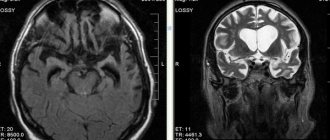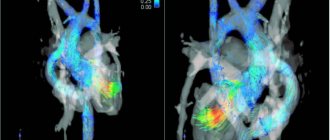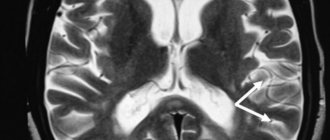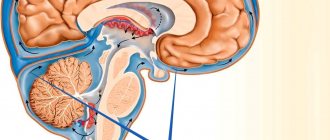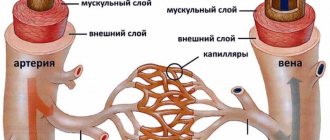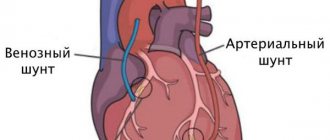There are three stages of chronic cerebral ischemia:
- Stage 1 (initial) is characterized by a large number of various complaints of headache, irritability, insomnia, a feeling of “heaviness” in the head, decreased memory for immediate events, fatigue, poor coordination of movements, and instability when walking. These changes are not noticeable to others and patients remain adapted to society. A neurological examination reveals minimal symptoms, a clear neurological deficit has not yet formed, and adequate therapy can reduce or eliminate individual manifestations of the disease.
- Stage 2 (subcompensation) the frequency of complaints about loss of memory and performance, instability, and dizziness increases. A leading clinical syndrome is formed, and a neurological deficit becomes obvious. Cognitive, personality, and emotional-volitional disorders worsen. Adaptation to society and professional skills fade, but the possibility of self-care remains.
- Stage 3 (decompensation) Objective neurological disorders come to the fore. The number of complaints decreases due to decreased criticism of one’s condition. On examination, several well-defined neurological syndromes are noticeable. Cognitive impairments at the advanced stage of chronic cerebral ischemia are very often the leading cause of disability, their everyday adaptation suffers, patients are unable to work, require constant outside care, and vascular dementia develops.
In the clinic of chronic cerebral ischemia, several main neurological syndromes are distinguished. These include cephalgic, vestibulo-atactic, psychopathological, paroxysmal syndrome, pyramidal insufficiency, pseudobulbar syndrome.
Cephalgic syndrome is characterized by pain in various parts of the head. Often there is no connection between headaches and hemodynamic disorders. As chronic cerebral ischemia progresses, headache attacks become less frequent.
Vestibulo-atactic syndrome is one of the most common in patients with chronic cerebral ischemia. It includes vertigo, loss of coordination, instability, and noise in the head. These complaints arise from circulatory failure in the vertebrobasilar system, as well as age-related changes in the vestibular apparatus, ischemia of the vestibulocochlear nerve.
Paroxysmal disorders in chronic cerebral ischemia are varied and include episodes of transient global amnesia, syncope, drop attacks, and epileptic seizures. The severity of such conditions increases as ischemia and concomitant diseases progress.
Mental disorders are often present at all stages of chronic cerebral ischemia. At first, they are of the nature of asthenoneurotic, depressive, and anxiety disorders; at stages II-III, they are joined by cognitive impairment, and dementia occurs.
Cerebral gliosis: to worry about or not to worry about?
If the skin is injured, scars form on it. Similar scars can form in the brain.
We talk about such a common pathology as gliosis with Oksana Egorovna Volkova, a radiologist, chief physician and executive director of MRI Expert Lipetsk.
“An MRI revealed gliosis of the brain,” sounds scary. Oksana Egorovna, tell us what cerebral gliosis is?
This is the replacement of dead neurons with neuroglial cells. There are different types of cells in the brain. The main cells are neurons, thanks to which neuropsychic processes occur. These are the very cells that are said to “not recover.”
Another type is glial cells (neuroglia). Their function is auxiliary; they participate, in particular, in metabolic processes in the brain.
Nature, as we know, abhors a vacuum. Therefore, if neurons die for one reason or another, then their place is taken by neuroglial cells. Here we can draw an analogy with skin trauma. If the damage is significant enough, a scar will form in its place. An area of gliosis is also a “scar”, but in nervous tissue.
— Is cerebral gliosis an independent disease or a consequence of other diseases?
This is a consequence of other diseases.
Read the material on the topic: Vegetative-vascular dystonia: diagnosis or fiction?
— For what reasons do glial foci of the brain develop?
The causes of cerebral gliosis are different. It can be congenital, and also develops against the background of a large number of brain pathologies. The most common foci of gliosis appear in response to a vascular disorder. For example, there was a blockage of a small vessel. The neurons in the area of its blood supply died, and their place was filled with glial cells. Gliosis occurs during strokes, cerebral infarctions, and after hemorrhages.
IF THE SKIN DAMAGE IS SIGNIFICANT, THEN A SCAR WILL BE FORMED IN ITS PLACE. AN AREA OF GLIOSIS IS ALSO A “SCAR,” BUT IN NERVOUS TISSUE.
It can also form after injuries, with hereditary diseases (for example, a fairly rare disease - tuberous sclerosis), neuroinfections, after brain surgery, poisoning (carbon monoxide, heavy metals, drugs); around tumors.
— Before preparing the interview, we specifically studied people’s requests and found out that along with the phrase “gliosis of the brain,” Russians are trying to find out from search engines whether it is dangerous, fatal, and are even interested in the prognosis of life. How dangerous is cerebral gliosis for our health?
This depends on the cause of gliosis and what consequences the gliosis lesion itself can cause.
For example, a small blood vessel becomes blocked in a person and a patch of gliosis forms at the site of death. If everything is limited to this, and the site of gliosis itself is in a “neutral” place, then there may be no consequences “here and now”. On the other hand, if we see such a hearth, even a “silent” one, we need to understand that it appeared there for a reason.
Sometimes even a small focus of gliosis, but located in the temporal lobe, can “make itself known”, causing the appearance of epileptic seizures. Or an area of gliosis may disrupt the transmission of impulses from the brain to the spinal cord, causing paralysis of one limb.
Read the material on the topic: Is a brain cyst always a dangerous diagnosis?
Thus, it is always necessary to try to get to the bottom of the cause, since in some cases gliosis is a kind of “beacon”, a warning signal that something is wrong - even if now it does not bother the person at all.
— Cerebral gliosis and cerebral glioma are not the same thing?
Definitely not. Glioma is one of the most common brain tumors. Gliosis has nothing to do with tumors.
— Gliosis cannot develop into oncology?
No. It can occur with brain tumors, but as a parallel phenomenon - for example, against the background of concomitant vascular pathology.
Read the material on the topic: Why is MRI of cerebral vessels prescribed for headaches?
— What are the symptoms of cerebral gliosis?
The most diverse - based on the variety of pathologies that cause areas of gliosis to form. There is no specific symptom(s) of gliosis.
GLIOSIS HAS NO RELATION TO TUMORS. IT CANNOT GROW INTO ONCOLOGY.
Headaches, dizziness, unsteadiness of gait, variability in blood pressure, memory impairment, attention problems, sleep disorders, decreased performance, impaired vision, hearing, epileptic seizures and many others may occur.
— Oksana Egorovna, is gliosis visible on MRI?
Undoubtedly. Moreover, we can say with a certain probability what its origin is: vascular, post-traumatic, postoperative, after inflammation, with multiple sclerosis, etc.
Read the material on the topic: If an MRI of the brain showed...
— How can cerebral gliosis affect the patient’s quality and life expectancy?
It depends on the underlying disease. Asymptomatic gliosis after a minor traumatic brain injury is one thing, but a lesion in the temporal lobe that causes frequent epileptic seizures is another. Of course, the amount of damage to the nervous system and the resulting disorders (for example, during a stroke) also matter.
— Do glial lesions in the brain require special treatment?
And here everything depends on the underlying pathology. This issue is resolved individually by the treating doctor.
Read the material on the topic: What is hidden behind the diagnosis of dyscirculatory encephalopathy?
— What type of doctor should a patient see if gliosis is detected during an MRI scan of the brain?
To a neurologist, if indicated - to a neurosurgeon.
— If magnetic resonance imaging reveals foci of gliosis in the brain, does such a patient need dynamic observation?
Yes. Its frequency depends on the cause that caused the appearance of gliosis, the number and size of foci, their “behavior” during dynamic observation, etc. These issues are resolved by the attending physician and the radiologist.
You may also find it useful:
Does osteochondrosis exist?
Which tomograph is better: open or closed?
Why is electroencephalography needed? Complete patient guide
For reference:
Volkova Oksana Egorovna
In 1998 she graduated from Kursk State Medical University.
In 1999 she completed her internship in the specialty “Therapy”, in 2012 - in the specialty “Radiology”.
She worked as a radiologist in.
Since 2014, he has held the position of chief physician and executive director.
Basic examinations in patients with chronic cerebral ischemia:
- MRI of the brain, preferably with angiography
- blood pressure and ECG monitoring.
- general blood test, general urinalysis, biochemical blood test, coagulogram, blood lipid spectrum.
- fundus examination
- examination by an otoneurologist
- neuropsychological study.
- CDK BCS, TKDG, ECHO-KG
- examination by a psychotherapist to identify anxiety-depressive conditions and cognitive deficits).
Treatment and prevention of chronic cerebral ischemia should be aimed at correcting the current vascular disease. The focus is on antihypertensive therapy, prevention of thrombosis, and lowering blood cholesterol levels. Also an important component of treatment is the correction of concomitant diseases (diabetes mellitus, heart rhythm disturbances, heart failure, obesity), sleep disorders and anxiety-depressive disorders. Vascular therapy, neuroprotection, and improvement of neurometabolism play a significant role. A comprehensive treatment is recommended, including non-drug methods of influence: psychotherapy, exercise therapy, massage, physiotherapeutic treatment.
The First Neurology clinic presents a variety of hardware techniques that help improve cerebral circulation, such as mesodiencephalic modulation (MDM therapy), brain micropolarization, and electrosleep. Using the modern CEFALY neurostimulation technique, the intensity of headaches decreases, memory and concentration improve.
Diagnosis of glial changes in the brain
The presence of small single foci of gliosis in the brain, as a rule, does not manifest itself for a long time, and the patient may not suspect the occurrence of pathology for a long time. Gliotic foci can be noticed only during a brain examination for other reasons.
In the presence of multiple, large glial formations, the appearance of characteristic symptoms is inevitable. In the presence of such symptoms as headaches, surges in blood pressure, dizziness, increased fatigue, intellectual disorders, speech impairment, hearing impairment, vision impairment, paresis, severe mental disorders, etc. It is necessary to undergo a magnetic resonance imaging scan.
MRI is the main tool, a priority method, allowing to determine the presence of glial changes in the brain, determine their number, assess the size and timing of formation, and the extent of neuronal death.
Connective tissue has a special structure, and therefore differs from other types of soft tissues in a special type of signal, which is why MRI makes it possible to accurately identify foci of gliosis in various brain structures. On MRI images they appear as irregularly shaped, light-colored areas. Depending on the type of gliosis, they can be in the form of fibers, islands, spots, which are located in certain areas of the brain (along the vessels affected by atherosclerosis), under the membranes of the brain, on the inner membrane of the ventricles, chaotically or in an orderly manner.
Another advantage of magnetic resonance imaging of the brain is the ability not only to establish the very fact of the presence of glial changes, but also to establish their cause. The images will clearly show areas of the brain with malnutrition due to impaired vascular patency blocked by atherosclerotic plaques, areas of hematoma, inflammatory processes, neoplasms (cysts, tumors). A method that allows replacing already formed connective tissue with new nerve cells does not yet exist in medicine. However, MRI will play an important role here - it will allow us to establish the cause of the development of this disease in order to eliminate the provoking factor and prevent the worsening of the situation.
Our specialists
Tarasova Svetlana Vitalievna
Expert No. 1 in the treatment of headaches and migraines. Head of the Center for the Treatment of Pain and Multiple Sclerosis.
Somnologist.
Epileptologist. Botulinum therapist. The doctor is a neurologist of the highest category. Physiotherapist. Doctor of Medical Sciences.
Experience: 23 years.Derevianko Leonid Sergeevich
Head of the Center for Diagnostics and Treatment of Sleep Disorders.
The doctor is a neurologist of the highest category. Vertebrologist. Somnologist. Epileptologist. Botulinum therapist. Physiotherapist. Experience: 23 years.
Palagin Maxim Anatolievich
The doctor is a neurologist. Somnologist. Epileptologist. Botulinum therapist. Physiotherapist. Experience: 6 years.
Romanova Tatyana Alexandrovna
Pediatric neurologist. Experience: 24 years.
Temina Lyudmila Borisovna
Pediatric neurologist of the highest category. Candidate of Medical Sciences.
Experience: 46 years.
Zhuravleva Nadezhda Vladimirovna
Head of the center for diagnosis and treatment of myasthenia gravis.
The doctor is a neurologist of the highest category. Physiotherapist. Experience: 16 years.
Mizonov Sergey Vladimirovich
The doctor is a neurologist. Chiropractor. Osteopath. Physiotherapist. Experience: 8 years.
Bezgina Elena Vladimirovna
The doctor is a neurologist of the highest category. Botulinum therapist. Physiotherapist. Experience: 24 years.
Drozdova Lyubov Vladimirovna
The doctor is a neurologist. Vertebroneurologist. Ozone therapist. Physiotherapist. Experience: 17 years.
Symptoms of ischemic stroke of the left hemisphere
With a left-sided stroke, paralysis of the right side of the body develops, resulting in loss of sensation and muscle dysfunction. Poor circulation in the left hemisphere of the brain leads to the following disorders:
- change in speech;
- disturbance of mental activity;
- memory loss;
- misunderstanding the meaning of words.
Patients with left hemisphere ischemic stroke often become withdrawn and develop depression. The attentive attitude of the staff of the Yusupov Hospital allows them to improve their psycho-emotional state. In 30% of patients with left-sided ischemic stroke, paresis of the right half of the body is combined with disturbances in muscle-joint sensation, which has a significant impact on the restoration of range of motion in the limbs and significantly complicates the restoration of walking and self-care. With left-sided stroke, a number of patients develop impairments in sensitivity and the ability to perform purposeful movements while maintaining strength in the limbs and full range of motion.
Along with decreased sensitivity, patients with a left-sided stroke may develop specific sensations on the right side of the body:
- tingling or crawling sensation;
- inadequate perception of irritations: the patient perceives touch as pain, and a hot object as cold;
- pain (thalamic syndrome).
After an ischemic stroke, consequences in the form of impaired coordination of movements and speech dysfunction can manifest themselves throughout life.
Expert opinion
Author: Tatyana Aleksandrovna Kosova
Head of the Department of Rehabilitation Medicine, neurologist, reflexologist
According to statistics, ischemic stroke of the left hemisphere of the brain ranks first in the list of dangerous neurological pathologies. The consequences of the disease are extremely negative: about 20% of cases are incompatible with life, in 80% patients simply remain disabled.
Most often, the main cause of vascular circulation disorders in the brain is blood clots. They arise due to hypertension and lead to blockage of the lumen of the vessel. In addition, pathology can be caused by diseases such as high blood viscosity, rapid clotting, disorders of the heart and blood vessels, metabolism, diabetes mellitus, and slow blood circulation. Very often, ischemic stroke affects those who have had a heart attack, surgery to install a heart valve, or suffer from frequent headaches and migraines.
The main symptoms of ischemic stroke of the left hemisphere of the brain are sudden sudden headaches, dizziness, accompanied by nausea and convulsions, fainting, and coma. In this case, the patient’s right side of the body is paralyzed, the functions of speech and perception are impaired, the heart rate is disrupted, sweating increases and tremors of the limbs occur, the skin becomes grayish in color. Doctors at the Yusupov Hospital will conduct a quick examination and make an accurate diagnosis. Treatment is prescribed in accordance with the symptoms and severity of the pathology.
Read also
Swelling of the legs
Causes of Swelling in the Legs The legs are common sites for swelling due to the effect of gravity on the fluids in the human body.
However, fluid retention is not the only cause of leg swelling. Injuries… Read more
Hemorrhagic stroke
Hemorrhagic stroke is a type of acute cerebrovascular accident, which is characterized by the effusion of blood into the brain substance with the development of neurological deficit, often leading...
More details
Vegetative-vascular dystonia
Vegetative-vascular dystonia is a dysregulation of the autonomic nervous system, which manifests itself in the form of various clinical symptoms. This disease is diagnosed at different times...
More details
Atherosclerosis
What is atherosclerosis Atherosclerosis is a narrowing of the arteries caused by the formation of plaque. As a person gets older, fat and cholesterol can accumulate in the arteries and form plaque. Accumulation…
More details
Transient ischemic attack (TIA)
What it is? Why is this happening? Is this condition dangerous? What to do if doctors make such a diagnosis? These questions are always asked by patients who come to see a neurologist. According to classification...
More details
Gliosis: causes and mechanisms of development
Glial tissue is one of three types of brain tissue (along with neuronal and ependymal), which is essentially connective tissue; normally it makes up about 40% of the brain volume.
Its function is to preserve the very structure of the brain, ensure the supply of nutrients to the main cells of the brain - neurons, as well as physically protect neurons and give them a certain position. As neurons die from natural or pathological causes, they are replaced by glial tissue. Gliosis is the pathological proliferation of glial tissue, the appearance of large single or multiple foci of connective tissue (they look like scars) in the structures of the brain. Gliosis cells, although they replace dead neuron cells, cannot fully perform their functions, therefore, as a result of a lack of mechanisms for transmitting nerve impulses, neurological symptoms develop. The appearance of gliosis foci leads to disruption of the normal functioning of the brain - the patient’s attention and memory weaken, mental processes are disrupted, speech and movements become uncertain.
Such disorders are inevitable as a result of the natural aging of the body, but there are cases of premature pathological growth of glial foci in the brain structures of young and middle-aged people. In extremely rare cases, a person may experience congenital replacement of neurons with glial cells.
The nature of the occurrence of gliosis changes in the brain can be different. Brain diseases such as epilepsy, encephalitis, multiple sclerosis can lead to accelerated death of neurons and proliferation of connective tissue; vascular disorders, hypertension, anemia, trauma and cerebral edema can also cause gliosis. Provoking factors are: heredity, old age, excessive consumption of fatty foods and poor lifestyle in general.
Diagnosis of ischemic stroke
If an ischemic stroke is suspected at the Yusupov Hospital, the patient undergoes laboratory tests and is examined using instrumental methods using modern equipment from leading companies in Europe, the USA and Japan. The results of the examination allow us to make an accurate diagnosis and prescribe adequate therapy. In order to determine the type of stroke and determine whether the left or right side of the brain is affected, computed tomography or magnetic resonance imaging is performed. Immediately after neuroimaging of a stroke, the following studies are performed:
- electrocardiography;
- ultrasonography;
- blood tests.
The patient is then examined by an ophthalmologist and an endocrinologist. Later, additional diagnostic procedures are performed:
- X-ray of the skull;
- chest x-ray;
- electroencephalogram;
- echocardiography.
After an accurate diagnosis is made, treatment for ischemic stroke is prescribed.
